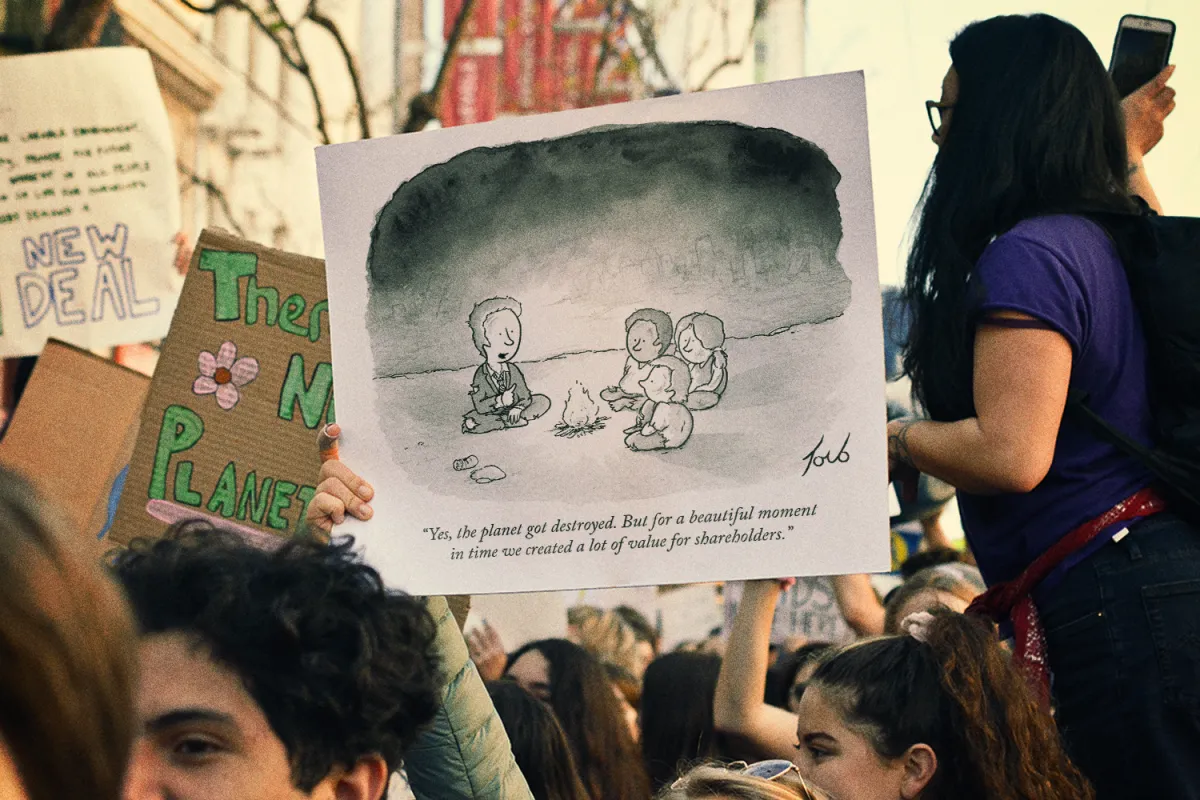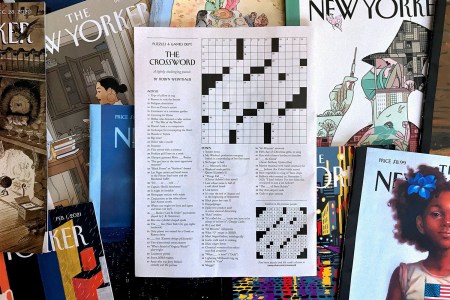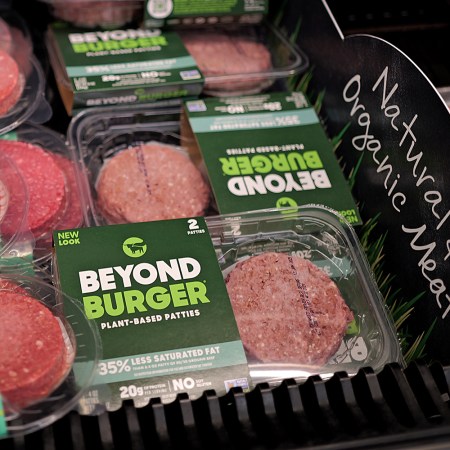On Monday, the Dow Jones Industrial Average hit a record high in the wake of the bipartisan infrastructure bill. It’s another win for the stock market and, subsequently, those who are tapped into its financial machinations. Meanwhile, over in Glasgow at the United Nations Climate Change Conference, or COP26, promises are being made to cut greenhouse gas emissions, but as Elizabeth Kolbert explains at The New Yorker, we’ve seen promises made and broken many times before. After all, it’s 2021 and these conferences began in 1995.
It’s a case of life imitating art, or more specifically, life imitating a cartoon. A while back, Tom Toro published a cartoon in The New Yorker that exquisitely captures this sentiment, that our obsession with wealth continues to suffocate the will to ensure a livable planet. In the illustration, a man in a raggedy suit sits next to a campfire among an apocalyptic landscape telling a story to three similarly grubby children. “Yes, the planet got destroyed,” he says. “But for a beautiful moment in time we created a lot of value for shareholders.”
That cartoon was published in 2012. Since then, it has snowballed from an inset on a page of a magazine into a viral summation of our current climate moment in 2021. Environmental champions like Greta Thunberg, Leonardo DiCaprio and Senator Bernie Sanders have all shared it on social media, Mr. Sanders personally sharing it multiple times over the years.
As COP26, which has been called the last best hope for the world limiting emissions, continues to inspire more dread than hope, we called up 39-year-old Toro, who has been a New Yorker cartoonist since 2010, to talk about his prophetic cartoon. We discussed the surprisingly frantic story behind the creation, why he thinks it struck a chord and what it’s like having your art shared by Jeff Bezos’s enemy number one.
This interview has been condensed and edited for length and clarity.

InsideHook: The cartoon I want to talk about today, do you know when it was first published?
Tom Toro: Yeah, I looked back at it and the exact date was the 25th of November, 2012. It’s coming on the nine-year anniversary.
Wow.
That’s a while ago.
Could you take me through what you remember about creating it, where the idea came from and what inspired you?
The exact story behind my submission of it — it was funny because I was not intending to submit cartoons that week. I was actually planning to take the week off because I was on a writing retreat with my friend. He had something else that he had to do that particular morning, so I was like, oh, I have a few hours, I’ll just throw together a batch for The New Yorker, even though I wasn’t planning to do them that week. So I sketched up some rough ideas really quick. I think it was right in the midst of — it was the presidential election, Obama versus Romney, so a lot of my ideas had to do with Romney and Paul Ryan, the politics of the time, but a few of them were just regular sketches that I threw in. I don’t remember how I came up with that idea itself, but I did them all very quickly and sent them off.
Then, I think it was the next day or even later that afternoon, the editor Bob Mankoff reached out and said, “We want this cartoon immediately. We want it this week,” which almost never happens. You send stuff in on Monday night, Tuesday morning, they look at the stuff on Tuesday or Wednesday, and then on Friday normally you’ll get an OK. If you’re lucky, they’ll say, “We want this one.”
The funny thing about The New Yorker is usually there’s no deadline to turn it in. They choose cartoons that aren’t necessarily topical. They like to let the journalism do the journalism and the cartoons are meant to not comment on anything directly but be based on normal, funny human interactions and social observation, stuff like that. Sometimes they will say, “We want this for A issue” — the issue they’re putting out that week, it’s called the A issue — so he said, “We want this for A issue,” which I’ve only had happen three times. I wasn’t at home, I wasn’t at my studio, my friend and I were off in some rented place, so I had to hurry back home and do the artwork that night. It’s probably the fastest cartoon I’ve drawn. I usually agonize over things, but I had to draw it really quickly and send it off because they had to put it out in the magazine.
It’s the one that I was not planning to submit and the final artwork that I’ve done the fastest, and it’s ended up being my most popular and enduring cartoon. It goes to show there’s something to say about the urgency and time pressure that adds a little fire to the creative process.
As far as the idea itself … I’ve always had an environmentalist bent to myself, and so I try and do some cartoons like that as much as possible. It’s rare for them to do ones that directly address issues like this, especially for the magazine, so I think this one somehow managed to thread that needle or get right up to the line of being a kind of editorial cartoon, which I don’t often do, but still having a sort of individual touch to it that makes it a New Yorker quality.
The only thing that I remember adjusting is I initially had it [read], “Yes, the planet got destroyed, but for a beautiful moment in time we created a lot of money for shareholders,” and I changed that to “value.” That was the one edit that I did. I think that “value” is funnier because it’s more of a corporate, vague term. It’s more of a corporatese kind of speak. Whoever this guy is, this hedge fund guy talking to these kids in this blighted landscape, using the word value is just funnier because it’s a little bit gentler, it’s a little more general. It sounds like what you would say as part of your deck pitch in a sales meeting or something.
Are Crossword Puzzles the Key to Saving Print Media?
Online games are the new frontier of old media, but that didn’t stop “The New Yorker” from introducing a print-edition crosswordYou said it’s your most popular cartoon, but after this cartoon got published in the magazine do you remember getting a response? I don’t really know if cartoonists get responses to their cartoons immediately after.
There were a couple of fellow cartoonists who reached out, and they’re like, “Oh, that’s a really good one.” That’s always the nicest compliment when you get them from your peers, so I remember a couple people were reaching out to me, which was gratifying.
Every year I submit my stuff to the National Cartoonists Society awards for best gag cartoon of the year, and it didn’t win. It didn’t get a lot of accolades. It wasn’t immediately recognized as something that would have the resonance that it’s ended up having. It’s been a slow growth of this recognition that it got. The funny thing is, when I first published it I was not on social media, so I don’t know if it got shared a lot then, or if I had a social media presence [and] would have posted it if it would have become a meme immediately.
When I emailed you I mentioned I’ve seen Greta Thunberg and Senator Sanders post the cartoon, and Bernie has posted it multiple times.
Yeah, that’s extremely flattering. It’s just crazy. I have to sometimes remind Mr. Sanders to tag me. It’s always good when they tag you. If I had a nickel for every time this was shared on social media, then I could retire. I think Leonardo DiCaprio has posted it. His Instagram account is basically all environmental stuff.
I joke that I’m eager for the day when my most popular cartoon is not relevant anymore because then we’ll have solved the problem that it’s lampooning. I like how these people, like Bernie Sanders and Greta Thunberg, how they seem to see themselves in it, or they see how it crystallizes their message in a clear and funny way.
It’s interesting to me that this was published in 2012. It was done, as you said, faster than you normally do cartoons, but it seems to sum up this moment that we’re in right now in 2021 so perfectly. Why do you think it’s struck such a chord?
I think because things are getting worse. I think there’s a greater acknowledgement of the urgency. We are able to ignore climate change, even though we’ve known about it since the ‘70s, maybe even earlier. We’ve been able to brush it under the rug like we do with so many of our existential problems, especially in America, but it’s getting to the point where you just can’t ignore it anymore. I think the cartoon works because it crystallizes the attitude that has allowed us to procrastinate this long, up until this point, where our priorities are totally upside down. We’re valuing short-term gain instead of long-term sustainability. I think, ironically, the worse things get, the more urgent the problem is pressing down on us, the more relevance the cartoon has.
Do you think cartoons can bring about change by themselves? Is that something you think about at all in your process?
Well it helps expiate my own guilt about not being more involved. I’ve done my bit. This is what I can do, now it’s up to everyone else. [laughs] No, I think it can draw attention. There’s a great quote by the former editor, Bob Mankoff, where he was like, “If something is worth saying, it’s worth saying funny.” It’s such a heartbreaking topic, ecological devastation is the worst, but this … the message is not overly aggressive, it’s not directly blaming anybody, it’s not self-righteous. It’s humorous, but it also gets across the point. We’re hungry for things that can be truthful, but in a way that’s palatable. I think that’s what cartoons are particularly good at doing.
You said that this is what you do, and it’s up to other people to figure it out, but I know you’ve sold prints to raise money for certain causes. You’ve given out free protest art, things like that.
As a cartoonist, I don’t have a ton of means. I’m not rich, so what I can offer is my talent, my artwork. Whenever there’s a cause that I’m particularly passionate about, I’ll try and leverage people buying prints and then I’ll donate those funds directly to whatever political or environmental cause that’s urgent at the time. I try and use what’s at my disposal to advance the causes that I believe in. As far as the giving away part, as our kid is getting older and it becomes clear how much we need to start putting into his college saving fund [laughs] I’m trying to not do as much stuff for free. As long as it’s for a good cause, I feel OK about that, because I also care about the future of the planet.
I do specific cartoons now for the Yale Climate Connections. There are some cartoons that I do directly about causes for their website. That’s the kind of thing where they find it useful to have a cartoon accompanying an article. In this age of social media, cartoons are the perfect medium because everything has to be quick, it has to be witty, and it has to be visual, so cartoons are a really good way to grab people’s attention and hopefully get them to look a little bit deeper.
I’m always looking for ways to do ones that fit into The New Yorker, but again, this was one of those rare ones where it was an issue cartoon, which I don’t normally do. I’ve done a lot of submissions in the same vein since then, which don’t get bought by them, but this is one that snuck through. I’m glad it did.
This article appeared in an InsideHook newsletter. Sign up for free to get more on travel, wellness, style, drinking, and culture.


























